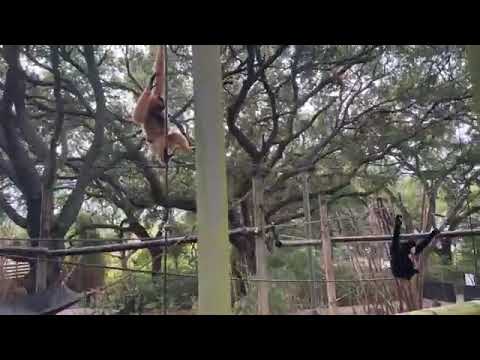1. Introduction to the White-Cheeked Gibbons and Meet Marv
2. The unique characteristics of white-cheeked gibbons
3. The bond between white-cheeked gibbon parents and their offspring
4. The Wortham World of Primates: A Glimpse into the gibbon family’s Habitat
5. Fascinating facts about white-cheeked gibbons
—
Welcome to our blog, where we invite you to embark on a thrilling journey into the world of zoology and nature. Today, we are delighted to introduce you to a new addition to our zoo family: Marv, the adorable white-cheeked gibbon. Born five weeks ago to first-time parents Max and Ting, Marv has stolen our hearts with its playful antics and endearing nature.
But before we delve into Marv’s delightful presence, let’s take a moment to explore the unique characteristics of white-cheeked gibbons. These magnificent creatures hail from Southeast Asia and are known for their striking appearance and extraordinary acrobatic skills. With their black fur and distinctive white cheek patches, they are instantly recognizable.
One of the most fascinating aspects of white-cheeked gibbons is their strong family bonds. When Marv was born, it instinctively clung to its mother’s fur, developing a tight grip lasting several months. This behavior is essential for the gibbon’s survival in the wild, allowing them to navigate effortlessly through the trees and avoid potential predators.
If you’re eager to meet our gibbon family, visit the Wortham World of Primates. This extraordinary exhibit provides an immersive experience, allowing you to observe these beautiful creatures in an environment that closely resembles their natural habitat. You’ll witness heartwarming moments between Max, Ting, and Marv as they swing from branch to branch and communicate through a mesmerizing array of vocalizations.
As we delve deeper into the world of white-cheeked gibbons, let us captivate you with some intriguing facts. Did you know that gibbons are renowned for their incredible agility and can make gravity-defying leaps of up to 50 feet? Their long arms, nearly twice the length of their bodies, enable them to effortlessly swing through the forest canopy, covering vast distances in mere minutes.
Another remarkable aspect of these gibbons is their melodic song, which resonates beautifully through the dense jungles they call home. Gibbons use their vocalizations to mark their territory and establish strong bonds with their family members. Each gibbon has its unique song, lasting up to 20 minutes, which they use to communicate their location to other gibbons in the area.
Intriguingly, while white-cheeked gibbons are highly social creatures, they are relatively monogamous. Max and Ting will likely remain devoted partners for life, raising multiple offspring together and maintaining a strong familial bond. This commitment and loyalty are exemplary traits that demonstrate the resilience of these gibbons and inspire us as humans to foster meaningful connections with our loved ones.
As you can see, adding Marv to our gibbon family is a cause for celebration. We are honored to witness this precious bond and are ecstatic to share this journey with our visitors. We hope that through your interactions with Marv and its devoted parents, you will gain a deeper appreciation for the wonders of nature and the beauty of wildlife.
So, whether you’re planning a visit to our zoo or simply joining us on this virtual expedition, let us immerse ourselves in the enchanting world of white-cheeked gibbons. Together, we can celebrate the miracles of life, the strength of family, and the incredible resilience of nature. Join us as we continue to protect and preserve these magnificent creatures, ensuring a future where they can thrive and inspire generations to come.
*****
Source Description
Meet Marv! Five weeks ago, our newest white-cheeked gibbon was born to first-time parents, Max and Ting. White-cheeked gibbons are born with the instinct to grip onto mom and will do so for quite a few months. You can see our gibbon family in Wortham World of Primates.

